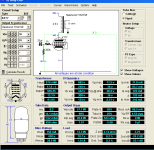I know output impedance is an important measure to the performance of PSU. But I wonder if it do have the same importance when the circuit is class A. I guess class A like single ended or even push pull topology should always draw the amount of current set at quiescent state and so there is no change in power requirement, which make the output impedance of PSU irrelevant. Is my understanding correct?
I think so for push pull, as one tube turns off as the other turns on.
But can't be true for single ended as i understand it.
The quiescent current can reduce to zero when the tube is close to turning off (max negative grid voltage), and can almost double when its driven towards max signal (close to zero grid volts).
Attach the results from the Tubecad SE app.
GlassWare Audio Design
But can't be true for single ended as i understand it.
The quiescent current can reduce to zero when the tube is close to turning off (max negative grid voltage), and can almost double when its driven towards max signal (close to zero grid volts).
Attach the results from the Tubecad SE app.
GlassWare Audio Design
Attachments
Last edited:
I came across quite a clever idea of fitting a Zener diode across the psu dropper resistor. This limits the voltage drop across the resistor when the current increases and therefore avoids most of the psu voltage sag.
Shouldn't it be about drawn current where the user likes very loud , very high current deep bass which for an instant reduces the current supply provided by the storage capacitors -aka- "smoothing capacitors " ?
That is a more important design problem in audio power amp supplies and was very well argued in the pages of EW between D.Self & JLH .
D.Self stating a simple supply is more capable of proving an "instantaneous " high current than any stabilized power supply --he got some backers but so did JLH .
That is a more important design problem in audio power amp supplies and was very well argued in the pages of EW between D.Self & JLH .
D.Self stating a simple supply is more capable of proving an "instantaneous " high current than any stabilized power supply --he got some backers but so did JLH .
I prefer unregulated supplies because regulation means another active device in series with the output devices. So generously rated transformer and smoothing caps.
My opinion is that regulated power supplies are a cost saving method much liked by commercial manufacturers.
My opinion is that regulated power supplies are a cost saving method much liked by commercial manufacturers.
Perhaps the issue to better appreciate is what happens during a single large-signal cycle. In an SE output stage, the valve is designed to cycle between the limit conditions of zero current and saturation current. Apart from the rising distortion the valve is introducing if pushed closer to those limits, the voltage applied to the output transformer primary winding is also modulated by the primary winding resistance and that current excursion.
Yes, and the Tubecad app is great for enabling you to see how the distortion changes with plate current and grid voltage swing.
Also useful for comparing 1,2,3 or 4 parallel tubes. For example. 2 KT77 pushed hard produce 18watts with a Hammond 1640SE OTP (1.5k) and fixed bias with distortion of 13% 2nd and 2.55 third.
Four in parallel with the same supply voltage (450) and transformer, produce 28w at a lower 50ma plate current and distortion of 7% and .6%
Also useful for comparing 1,2,3 or 4 parallel tubes. For example. 2 KT77 pushed hard produce 18watts with a Hammond 1640SE OTP (1.5k) and fixed bias with distortion of 13% 2nd and 2.55 third.
Four in parallel with the same supply voltage (450) and transformer, produce 28w at a lower 50ma plate current and distortion of 7% and .6%
And tube rolling could also show large distortion differences, so a lot of caution is needed when summarising outcomes.
This is the beauty of Broskie's SE design app - well worth $10.
You can amuse and educate yourself at the same time for hours as I have done, trying different transformers and tubes, paralleling them, changing the bias from cathode to fixed and varying the plate volts.
Pity he hasn't done one for PP amps as well nor allowed for pentode mode instead of triode strapped mode.
You can amuse and educate yourself at the same time for hours as I have done, trying different transformers and tubes, paralleling them, changing the bias from cathode to fixed and varying the plate volts.
Pity he hasn't done one for PP amps as well nor allowed for pentode mode instead of triode strapped mode.
I saved and have always liked an article written by Thorsten Loesch years ago on SE amp design. The PS section may give food for thought.
I am not sure that the website remains available, so I hope he doesn't mind me posting.
Bill
I am not sure that the website remains available, so I hope he doesn't mind me posting.
Bill
Attachments
- Home
- Amplifiers
- Tubes / Valves
- PSU output impedance requirement for class a
